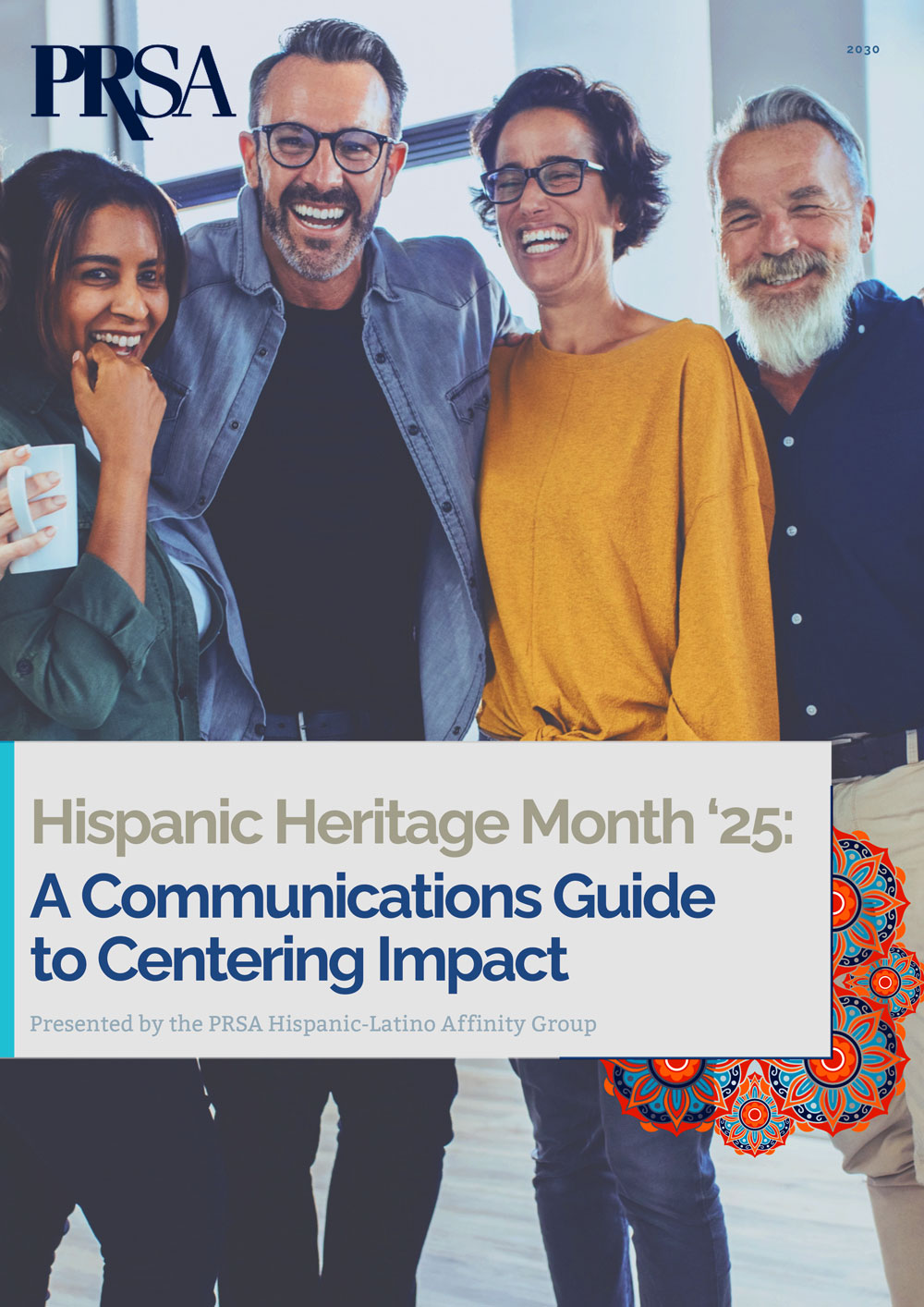Engaging Hispanic-Latino Communities With Authenticity
By Justine Mrsich, M.S., APR
October 2025
Growing up, education was the foundation of everything in my family. My mother, who emigrated from Ecuador and became a Spanish teacher, and my father, who ran a small business before finding his passion as a preschool teacher, taught me that community strength comes from both resilience and opportunity.
They believed deeply that education was the gateway to a better life, even pursuing their own degrees later in life while raising three children. Going to school was never optional; getting an education was our family’s “North Star.” As such, the commitment to growth and learning is a value that has lasted through my communications career. It echoes in all my work with diverse communities.
At its core, communications is about connection: helping people see themselves in stories, showing them their value in the larger narrative, and giving them tools to move forward with hope and confidence.
This lens is especially critical when we look at the United States’ Hispanic-Latino community — one I’m proud to be a part of and whose contributions are not only cultural but also profoundly economic.
A large economy, hiding in plain sight
According to the 2025 U.S. Latino GDP Report from UCLA and Cal Lutheran, the U.S. Latino Gross Domestic Product (GDP) reached $4.1 trillion in 2023, larger than the GDPs of the United Kingdom, India, or France, making it the fifth-largest economy.
Add to this the $2.7 trillion in purchasing power noted this year by Nielsen, and the remarkable 44% growth in Latino-owned businesses between 2018 and 2023 as reported in Stanford’s 10th annual State of Latino entrepreneurship report, and the story becomes clear: Latinos are not just participants in the U.S. economy. They are drivers of its future.
Yet, despite these undeniable numbers, the stories told about Hispanic-Latino communities are too often limited to clichés during Hispanic Heritage Month or overshadowed by rhetoric that highlights challenges rather than contributions. For communicators, this is a missed opportunity — not only to honor reality, but also to help create a stronger, more united future.
Communicating through headwinds
We also need to acknowledge that this is a challenging time. Latino and Hispanic communities across the U.S. continue to face uncertainty — from immigration debates to cultural polarization. Reports from organizations such as UnidosUS and the American Immigration Council have highlighted critical pressures that our communities encounter.
But here’s the opportunity: Thoughtful communications can serve as a counterweight. By centering authentic stories of resilience, entrepreneurship and leadership, we give voice to the lived realities of millions while providing a rallying point that keeps communities connected, inspired and proud. Think of communications not just as a campaign but as a cultural anchor. When external forces push toward division, the stories we amplify can pull communities back toward cohesion.
What communicators can do
So how do we move beyond performative gestures and tell stories that truly matter? A few strategies stand out:
1. Pair data with humanity.
Numbers like the $4.1 trillion Latino GDP are powerful, but data alone doesn’t connect hearts. As communicators, our task is to show what that number means in human terms — the small business owner opening her third bakery, the healthcare worker on the front lines (part of the 2.2 million Hispanic healthcare workers identified by the American Immigration Council), the student whose scholarship fuels tomorrow’s innovations. Data provides credibility; stories provide connection.
2. Keep culture at the center.
Culture is not decoration — it is the glue that holds communities together, especially in hardship. That means resisting stereotypes and instead showcasing the diversity within Latino identity: Afro-Latino, Indigenous, LGBTQ+ and multigenerational perspectives. The 2025 PRSA Hispanic Heritage Month Toolkit emphasizes this, urging communicators to spotlight underrepresented voices and avoid one-size-fits-all language.
3. Engage local voices and partners.
The most trusted messengers are often within the community itself. Co-create campaigns with Hispanic chambers of commerce, local nonprofits, and Employee Resource Groups (ERGs). Integrate Hispanic voices at every stage of development from ideation to review to increase campaign impact.
4. Acknowledge challenges without dwelling on them.
Campaigns don’t need to take political stances, but they should never ignore the difficulties communities face. Acknowledgment builds trust. By framing stories around resilience and progress — rather than deficit — we demonstrate respect while offering hope.
5. Treat Heritage Month as a launchpad, not a deadline.
Use Hispanic Heritage Month as a springboard for year-round engagement. Whether through supplier diversity initiatives, philanthropic commitments, or ongoing cultural storytelling — make celebrations the beginning of a longer conversation, not the end of one.
The communicator’s responsibility
As communicators, our work is about reputation, but it’s equally about responsibility. The stories we spotlight shape public perception and influence public policy. By championing narratives that reflect Latino communities’ immense contributions, we not only protect reputations, we also strengthen communities.
The stakes are high. The U.S. Bureau of Labor Statistics records Latino workers’ labor force participation rate at nearly 67% in 2023, compared to 62% for non-Hispanics. Since 2010, Latinos have accounted for nearly 59% of U.S. labor force growth. The American Immigration Council reports that Latino households contribute over $309 billion in taxes annually — directly funding national and local public services and infrastructure.
Beyond the balance sheets, Latino culture fuels our music, cuisine, art and innovation. This is not a side story; it is an American story.
The Hispanic-Latino economic story is more than numbers; it’s the people whose dreams, sacrifices and innovations drive America forward.
Join us in the PRSA Hispanic-Latino Affinity Group — a community built on connection, recognition and support. Become part of our group at connect.prsa.org. Log in with your PRSA credentials, click “All Communities,” and select the Hispanic-Latino Affinity Group. You’ll find more than just a professional network — you’ll find a place where your voice matters, where your contributions are recognized and where community is always waiting.
Because no matter where you are in your career, you can always find belonging with us.
La comunidad es nuestro mayor recurso, hoy y siempre. Únete a nosotros.

Hispanic Heritage Month 2025
PRSA is pleased to unveil the 2025 Hispanic Heritage Month Toolkit, titled “A Communications Guide to Centering Impact.” This resource is designed to assist communications professionals in celebrating with authenticity, respect and effectiveness. The toolkit offers storytelling frameworks, activation ideas, language and engagement strategies, and curated resources to recognize the diverse contributions of Hispanic and Latino communities. Access the toolkit on the PRSA website.



